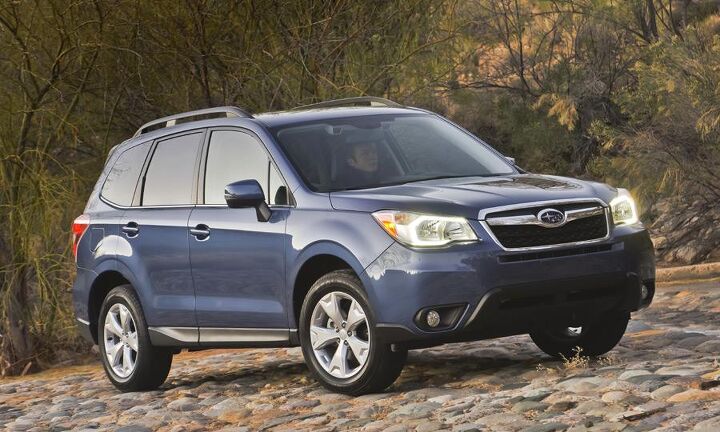Subaru Prepares For Largest Recall Yet

Expanding by leaps and bounds in the new millennium, Subaru effectively quadrupled its share of the U.S. market in the process. However, most of its production growth occurred in the last decade — leading to quality control problems unbefitting for a company that prides itself in sharing the same love as its customers.
Recalls are to be expected. No automaker can escape faulty components forever. But the frequency and scope of Subaru’s recalls (and scandals) over the past few years are especially bothersome, as they hint at an inability to catch mistakes, or perhaps a willingness to cut corners, as the company’s production volume targets the stratosphere. A new recall looming on the horizon will probably be the company’s largest to date.
According to Reuters, Subaru plans to recall roughly 2.3 million vehicles globally over a defective brake light switch — an issue that could potentially confuse the ignition, making it impossible to start the car. However, that’s a secondary issue of the potential confusion it could create for motorists travelling behind the vehicle.
Affected vehicles include Impreza and Forester models manufactured between 2008 and 2017, according to the automaker. The outlet reported Subaru as saying nearly 2 million of the cars hail from North America, with another 300,000 located in Japan. That’s a lot of fixing to add to the company’s already long list of recalls.
From Reuters:
Since late 2017, Subaru has been reeling from a host of problems ranging from faulty components to inspection re-dos which, coupled with weakening sales in the United States, has forced the automaker to slash its full-year profit outlook to its weakest in six years.
Quality-related issues have cast a pall on the automaker which enjoyed years of rapid growth in the United States, where it won over affluent and liberal-minded consumers with advertisements featuring slogans championing love and inclusion.
Such branding boosted the image of the tiny automaker, prompting it to ramp up production in the United States, which accounts for around 60 percent of its global sales volume.
Unfortunately, the automaker’s feel-good image is being tarnished as Subaru evolves into a larger company. Last year, Subaru admitted to falsifying fuel economy data after being faulted for decades of improper final inspection procedures in 2017.
Meanwhile, recalls have gotten out of hand. Over the last 12 months, the manufacturer halted production to address a defective power-steering unit, recalled 320,000 cars with weak valve springs, 229,000 vehicles with faulty software, and a couple hundred crossovers that made it out of the factory only partially welded.
As Subaru is growing at an incredible pace, introducing new models in the process, the company has a pretty good excuse for losing its previously admirable reputation for dependability. However, that doesn’t bode well for future growth — especially once the general public stops seeing it as the ultra-reliable brand it used to be. Subaru is losing what makes it special, and those endearing ad campaigns can’t do all of the heavy lifting. Brand loyalists will eventually smarten up and start cross shopping if the company doesn’t turn this around.
[Image: Subaru]

A staunch consumer advocate tracking industry trends and regulation. Before joining TTAC, Matt spent a decade working for marketing and research firms based in NYC. Clients included several of the world’s largest automakers, global tire brands, and aftermarket part suppliers. Dissatisfied with the corporate world and resentful of having to wear suits everyday, he pivoted to writing about cars. Since then, that man has become an ardent supporter of the right-to-repair movement, been interviewed on the auto industry by national radio broadcasts, driven more rental cars than anyone ever should, participated in amateur rallying events, and received the requisite minimum training as sanctioned by the SCCA. Handy with a wrench, Matt grew up surrounded by Detroit auto workers and managed to get a pizza delivery job before he was legally eligible. He later found himself driving box trucks through Manhattan, guaranteeing future sympathy for actual truckers. He continues to conduct research pertaining to the automotive sector as an independent contractor and has since moved back to his native Michigan, closer to where the cars are born. A contrarian, Matt claims to prefer understeer — stating that front and all-wheel drive vehicles cater best to his driving style.
More by Matt Posky
Latest Car Reviews
Read moreLatest Product Reviews
Read moreRecent Comments
- Lou_BC Well, I'd be impressed if this was in a ZR2. LOL
- Lou_BC This is my shocked face 😲 Hope formatting doesn't fook this up LOL
- Lou_BC Junior? Would that be a Beta Romeo?
- Lou_BC Gotta fix that formatting problem. What a pile of bullsh!t. Are longer posts costing TTAC money? FOOK
- Lou_BC 1.Honda: 6,334,825 vehicles potentially affected2.Ford: 6,152,6143.Kia America: 3,110,4474.Chrysler: 2,732,3985.General Motors: 2,021,0336.Nissan North America: 1,804,4437.Mercedes-Benz USA: 478,1738.Volkswagen Group of America: 453,7639.BMW of North America: 340,24910.Daimler Trucks North America: 261,959


































Comments
Join the conversation
Hi Liam, I read your post and wanted to share my full disclosure experience(s). Toyota is my favorite automobile manufacturer, I owned 4 of their automobiles - new. Subaru is a close second for me. I've owned 3, new Subaru's. I have also owned 4 Honda's, of which I easily had the most issues with. Combined, I put roughly 100,000 miles on the 4 'Yota's (one was involved in an accident that was deemed a total loss after four months of ownership), 115,000 miles on the 3 Subies, and 90,000 ,miles on the 5 Honda's. Of the four Toyota's the biggest repair I had was a malfunctioning cruise control stock. This issue was fixed under warranty and I was provided with a free loaner during the process. My Subaru's gave me not one issue between the 3 of them. I did put new tires on one of the them but I chalked that up to aggressive driving and mileage wear and tear. My Honda's were my problem children. My Civic burned at lest a complete quart of oil in-between oil changes. No leaks in my garage, the engine had to have been burning it off. My second Civic had a moon roof with a mind of its own and Leaked a plenty. Of the 3 new Fit's I owned one of them had the A/C compressor die on me. I was covered but with less than 15,000 on the odd, I was skeptical. Two recalls on one of my other Fit's as well as he dreaded air bad recall on my last Fit. I currently own my first Mazda, No ploblems as of yet but Ive only put 35,000 miles on it in the last two years.
2010 Forester; did timing belt last summer at 115K with no head gasket symptoms. Now at 124K we need new head gaskets. Given Subaru's poor history with head gaskets, it'll be hard to justify returning to Subaru for our next new car. Given how trouble free our 2012 Mazda5 (with a stick!) has been at 105K and counting, perhaps their Forester-class CUV is worth a look.